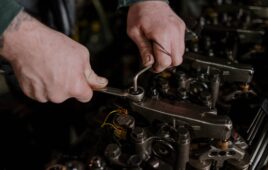By Henry Yates, Technical Sales Engineer, Rotor Clip Company, Inc. Somerset, NJ
Flatwire wave springs and retaining rings are used in a variety of quick connectors and circular plug-in connectors with threaded and bayonet locks. They are used for military, aerospace, and industrial applications. You have the choice of single, nested, and multi-turn wave springs.
A single-turn wave spring with overlapping ends saves axial space so that more space is given for travel (30% more travel compared to a standard coil spring). The spring clings to the bore, which saves more radial space compared to a stamped wave washer. The overlapping ends prevent radial jamming because a circumferential movement is allowed. The spring ends could move against each other so that the specification ‘load at work height’ is always given.

Flatware wave springs and retaining rings are used in quick connectors and circular plug-in connectors with threaded and bayonet locks. They are used for military, aerospace, and industrial applications.
The spring is coiled so there are no stamping burrs to cause scratching of the housing or shaft. The overlapping ends also have edges with a radius, which also prevent scratching. After connecting the male and female component of the quick connector, the wave spring provides a constant force at its work height with a low load tolerance of ±10% max. This is important to guarantee enough force for a continuous, safe connection. Stainless steel and exotic materials can be used to provide the correct amount of corrosion resistance as required (e.g. AISI 316 stainless steel for offshore connectors).
Nested wave spring
Some quick connectors require higher forces to guarantee a certain connection because of safety regulations which were set up by the government or specified by military and aerospace guidelines. Single-turn wave springs are limited in their load because of limitations regarding the wire sizes for specific diameters. A nested wave spring could be used for these requirements.

Constant section rings do not have lugs or lug holes like traditional tapered rings. As a result, they are less likely to interfere with other components like cables or the male component of the quick connector.
A nested-wave spring provides a higher load than a single-turn wave spring (a stamped wave washer) and uses the same radial space as a single-turn design. Overall, less radial space is needed compared to a disc spring, which will also provide higher loads; travel is much higher compared to a single disc spring. Only one part must be handled for assembly; no stacking of single turn designs, stamped parts or disc springs are necessary.
Multiple Turn Wave Spring
Using a multiple turn wave spring has the same advantages of a single-turn wave spring but with some key differences. Multiple-turn wave springs do not cling to the bore, because radial jamming has a significant effect on the specified load at work height. If the design of the multi turn wave spring resulted in peripheral movement of the turns against each other, then this could cause problems and render the spring unstable.
Compared to a single-turn design bigger travel/deflection is possible because the deflection in total is split. Every turn has to tolerate less deflection compared to a single-turn design. Use of a multi-turn wave spring could also save 50% in axial space compared to a traditional coil spring. There is also no concern about torsional movements during the compression to work height as there is with a coil spring; a wave spring always provides its load in axial direction. Very similar loads without big tolerances are provided at different work heights; in that way the application could be easily adjusted to meet given requirements.

Multiple-turn wave springs do not cling to the bore, because radial jamming has a significant effect on the specified load at work height.
Two-turn retaining rings and snap rings
Using flatwire two-turn retaining rings and snap rings with constant sections offers additional flexibility to the designer looking to meet the specifications of a unique application. Constant section rings do not have lugs or lug holes like traditional tapered rings. As a result, they are less likely to interfere with other components like cables or the male component of the quick connector.

A single-turn wave spring with overlapping ends saves axial space so that more space is given for travel. The spring clings to the bore, which saves more radial space compared to a stamped wave washer.
The ID/OD-lock function can be easily designed to generate a permanent assembly between the connector cap and inner component. Since these rings are not stamped, there are no sharp edges or burrs that could scratch soft surfaces like plastic housings. Two-turn retaining rings provide a 360° closed surface of contact, preventing soft materials like a rubber sealing element from being pushed through a gap; no local maxima of a wave spring could move into a gap so that the specified ‘load at work height’ is influenced negatively. AISI 316 stainless steel as a standard material offers perfect corrosion resistance for offshore applications.
Discuss this on The Engineering Exchange:

Rotor Clip Company
www.rotorclip.com





Tell Us What You Think!